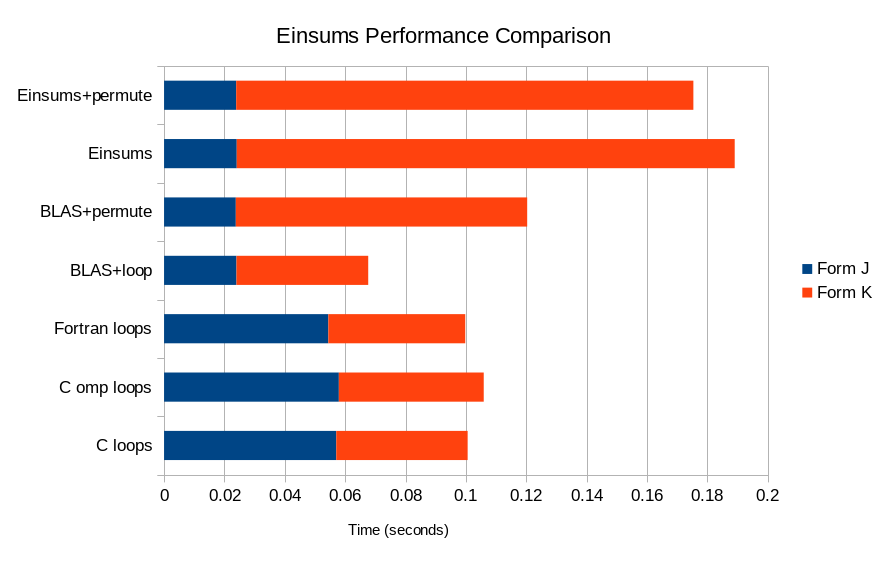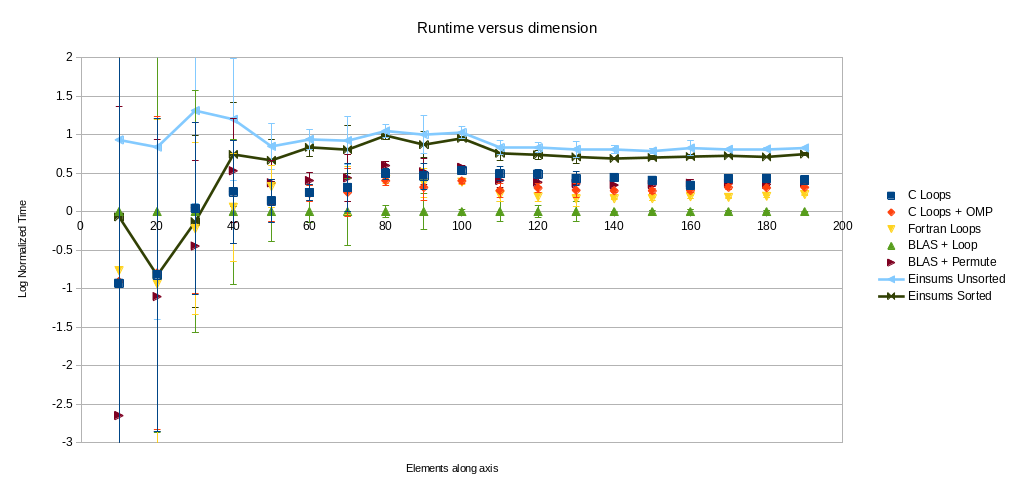Einsums User Guide#
This guide is an overview and explains the important features; details are found in the reference. Follow the links below to find more information on the specific parts of Einsums.
User's Reference
Extras
Design Goals#
The overall goal of Einsums is to allow scientists and mathematicians to write highly parallelized code without needing to become a wizard in high-performance computing. Another goal is to have an interface that mimics mathematical notation as closely as possible, so users don’t necessarily need to think about how to transform their equations into code. As an example, one might construct the Einstein tensor using the following equation.
This would become the following code using Einsums.
Tensor ricci_tensor{"R", 4, 4}, metric_tensor{"g", 4, 4};
double ricci_curvature;
// Initializations of all of these.
Tensor einstein_tensor{"G", 4, 4};
einstein_tensor = ricci_tensor - 0.5 * ricci_curvature * metric_tensor;
Another example for a more general contraction is the coupled-cluster singles and doubles energy expression. The governing equation is this.
This becomes the following code.
double E_hf;
int n_occ; // The number of occupied orbitals.
int n_orbs; // The number of orbitals.
int n_virt = n_orbs - n_occ; // The number of virtual orbitals.
Tensor F{"F", n_orbs, n_orbs}; // The Fock matrix.
Tensor TEI{"G", n_orbs, n_orbs, n_orbs, n_orbs}; // The electron repulsion integrals.
Tensor t1_amps{"T1", n_occ, n_virt};
Tensor t2_amps{"T2", n_occ, n_occ, n_virt, n_virt};
// Populate these values.
double E_ccsd = E_hf;
// Defining an intermediate.
Tensor tau2{"tau2", n_occ, n_occ, n_virt, n_virt};
tau2 = t2_amps;
einsum(0.25, index::Indices{index::i, index::j, index::a, index::b}, &tau2, 0.5, index::Indices{index::i, index::a},
t1_amps, index::Indices{index::j, index::b}, t1_amps);
// Compute the antisymmetrized two-electron integrals.
Tensor TEI_antisym = TEI;
permute(1.0, index::Indices{index::p, index::q, index::r, index::s}, &TEI_antisym, -1.0, index::Indices{index::p, index::q, index::s, index::r}, TEI);
// Computing each term.
TensorView Fia = F(Range{0, n_occ}, Range{n_occ, n_orbs});
einsum(1.0, index::Indices{}, &E_ccsd, 1.0, index::Indices{index::i, index::a}, Fia, index::Indices{index::i, index::a}, t1_amps);
TensorView TEI_ijab = TEI_antisym(Range{0, n_occ}, Range{0, n_occ}, Range{n_occ, n_orbs}, Range{n_occ, n_orbs});
einsum(1.0, index::Indices{}, &E_ccsd, 1.0, index::Indices{index::i, index::j, index::a, index::b}, TEI_ijab, index::Indices{index::i, index::j, index::a, index::b}, tau2);
Runtime Comparisons#
Einsums is an easy to use library that is also quite fast. To show this, we benchmarked the code for the following equation used in quantum chemistry against several different methods.
The code for the benchmarks can be found in devtools/profiling along with a spreadsheet containing the raw timings to update these images as we improve our algorithms. The benchmark was performed on a system with the following specifications.
CPU |
Model |
Intel Core i7-13700 K |
Clock |
3.4 GHz |
|
Cache |
30 MB |
|
Cores/Threads |
16/24 |
|
GPU |
Model |
AMD Radeon RX 7900 XTX |
Memory |
24 GB |
|
System |
Memory |
32 GB + 62 GB swap |
Storage |
2 TB NVME SSD storage |
|
Operating System |
Debian Bookworm |
|
Einsums Version |
2.0.0-beta |
|
C++ Compiler |
GCC 15.1.0 |
|
Fortran Compiler |
GCC Fortran 12.2.0 |
|
BLAS Vendor |
OpenBLAS 0.3.29 with OpenMP |
The tensor contraction was performed in several different ways: for loops in C; for loops in C with OpenMP SIMD vectorization and parallelization; CONCURRENT DO loops in FORTRAN; BLAS gemv call for the J matrix and an explicit loop in C++ for the K matrix; BLAS gemv call for the J matrix, then permuting the two-electron integrals to allow for a gemv call to be used for the K matrix; Einsums without permuting the two-electron integrals for the K matrix; and Einsums with permutation of the two-electron integrals for the K matrix. This first image shows the breakdown of the timing for building the individual matrices. The build time for the G matrix is not included as its contribution is too small to see.

As we can see, Einsums is a bit slower than raw BLAS, but still has comparable performance to a bare loop in C.

In the above image, we can see how Einsums compares to the alternatives for various sizes of the input tensors. It seems to grow in a similar fashion to the alternatives.

Since the previous graph is difficult to read for small sizes of the tensors, this provides a comparison that is normalized to the BLAS timings. Error bars are provided to show that the lower end is dominated by noise, and so the ordering might not be trustworthy.
Capabilities and Limitations#
As of right now, Einsums is capable of the following:
General contractions between two tensors of the form \(C_{ijk\cdots} = \alpha C_{ijk\cdots} + \beta A_{abc\cdots} B_{xyz\cdots}\).
Generalized transpositions of the form \(C_{ijk\cdots} = \alpha C_{ijk\cdots} + \beta A_{abc\cdots}\).
Linear algebra on tensors using BLAS and LAPACK as a backend.
Taking advantage of tensor layout. If the tensor is block diagonal or has blocks of zeros, the
BlockTensorandTiledTensorclasses can parallelize certain operations.Mapping operations over all of a tensor’s indices.
- Limited interaction with Python.
A form of the
einsumcall works in Python. All Einsums functions exposed to Python can also consume NumPy arrays.
GPU acceleration for all of the above using HIP. Uses hipBLAS and hipSolver for the GPU linear algebra operations.
Simple arithmetic between tensors. The tensors all need to have the same dimensions, though, and this does not yet work on GPU.
Tensors representing functions of their indices.
The following is not supported, but may be supported in the future.
When calling
einsum, there is no transposing of the indices. If a call can not be optimized without transpositions, it will use the generic algorithm rather than transpose indices until it can optimize the call.Most simple arithmetic does not work on
BlockTensor,TiledTensor,FunctionTensor, or any tensor for the GPU.The Python module only supports contiguous tensors. It does not support block-sparse tensors, function tensors, or others.
The Python module interacts with Einsums in a completely different way than C++. Be careful of pitfalls when working with interoperable code.
Multi-node acceleration using MPI or similar.
Tensors stored on disk are not fully fleshed out yet, and the interface is not yet stable.
